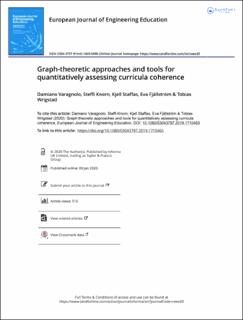| dc.contributor.author | Varagnolo, Damiano | |
| dc.contributor.author | Knorn, Steffi | |
| dc.contributor.author | Staffas, Kjell | |
| dc.contributor.author | Fjällström, Eva | |
| dc.contributor.author | Wrigstad, Tobias | |
| dc.date.accessioned | 2021-02-25T11:51:38Z | |
| dc.date.available | 2021-02-25T11:51:38Z | |
| dc.date.created | 2020-12-27T16:14:04Z | |
| dc.date.issued | 2020 | |
| dc.identifier.issn | 0304-3797 | |
| dc.identifier.uri | https://hdl.handle.net/11250/2730385 | |
| dc.description.abstract | In this paper, we propose a method to analyse the coherence of existing curricula at higher education institution. We focus our attention to engineering programmes at universities but the proposed method is by no means restricted to those cases. In contrast to other known methods, our approach is quantitative, decentralised, and asynchronous and allows to analyse entire programmes (in contrast to single courses) and does not depend on using specific teaching methods or tools. We propose to perform this quantitative assessment in two steps: first, representing the university programme as an opportune graph with courses and concepts as nodes and connections between courses and concepts as edges; second, analysing the structure of the programme using methods from graph theory. We thus perform two investigations, both leveraging a practical case – data collected from three engineering programmes at two Swedish universities: (a) how to represent university programmes in terms of graphs (here called concepts-courses graph (CCG)) and (b) how to reinterpret the most classical graph-theoretical node centrality indexes and connectivity and network flow results in order to analyse the programme structure, including to discover flows and mismatches. | en_US |
| dc.language.iso | eng | en_US |
| dc.publisher | Taylor & Francis | en_US |
| dc.rights | Attribution-NonCommercial-NoDerivatives 4.0 Internasjonal | * |
| dc.rights.uri | http://creativecommons.org/licenses/by-nc-nd/4.0/deed.no | * |
| dc.title | Graph-theoretic approaches and tools for quantitatively assessing curricula coherence | en_US |
| dc.type | Peer reviewed | en_US |
| dc.type | Journal article | en_US |
| dc.description.version | publishedVersion | en_US |
| dc.source.journal | European Journal of Engineering Education | en_US |
| dc.identifier.doi | 10.1080/03043797.2019.1710465 | |
| dc.identifier.cristin | 1863399 | |
| dc.description.localcode | © 2020 The Author(s). Published by Informa UK Limited, trading as Taylor & Francis Group This is an Open Access article distributed under the terms of the Creative Commons Attribution-NonCommercial-NoDerivatives License (http://creativecommons.org/licenses/by-nc-nd/4.0/), which permits non-commercial re-use, distribution, and reproduction in any medium, provided the original work is properly cited, and is not altered, transformed, or built upon in any way. | en_US |
| cristin.ispublished | true | |
| cristin.fulltext | original | |
| cristin.qualitycode | 1 | |

